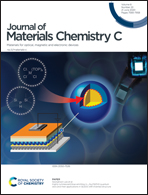First member of an appealing class of cyclometalated 1,3-di-(2-pyridyl)benzene platinum(ii) complexes for solution-processable OLEDs†
Abstract
The preparation and characterization of a new platinum(II) complex bearing a N^C^N-cyclometalating ligand and a thiolate coligand, namely 5-mesityl-1,3-di-(2-pyridyl)benzene and 1-phenyl-1H-tetrazole-5-thiolate, is reported. Its structure is determined by X-ray diffraction studies on a single crystal. This new complex exhibits green and red phosphorescence in dichloromethane solution (Φlum = 0.90) and in the solid state (Φlum = 0.62), respectively. In both cases the quantum yield is impressive showing for the first time that N^C^N platinum(II) complexes with a suitable thiolate coligand can reach outstanding luminescence properties. The excellent solubility of this complex allows fabrication of green processable solution-OLEDs with maximum EQE similar to that obtained with more expensive vacuum techniques and, depending on its concentration, one can tune the color of the OLED. The molecular geometry, ground state, electronic structure, and excited electronic states of the complex, both as a monomer and dimer aggregate in solution, are calculated by density functional theory (DFT) and time-dependent DFT approaches, giving insight into the electronic origin of the absorption spectra. Remarkably, the dimer is less sensitive to oxygen quenching than the monomer because the two 1-phenyl-1H-tetrazole fragments protect the platinum(II) centers, as suggested by a combination of luminescence studies and theoretical calculations.



 Please wait while we load your content...
Please wait while we load your content...